Basil downy mildew, discussed in the previous Pest Report, has been confirmed in Cape Cod, so be aware that it could be in Maine, or arriving with future storms.
Hornworm moths have been spotted, and young larvae are not far behind, or likely already present. While we usually call them both ‘tomato hornworms’ the most common species in the Northeast is actually the very closely related tobacco hornworm – but it makes little difference because they both love eating tomatoes and peppers.
It’s always tricky to decide when to talk about Cucurbit downy mildew here in Maine, because it often doesn’t show up here in time to be a major problem, though it has very destructive potential. The disease has made it as far as New Jersey and western New York, however, so it’s best to keep an eye on its progression. The disease spread forecasting model discussed below suggested that Massachusetts growers were at risk from the storms last week, which could create a source of inoculum for Maine growers, however, there have not been any confirmed cases reported from Massachusetts yet.
Much of the feeding damage from scarab beetles, like Japanese beetle feeding, is obvious because you can see them doing it. Asiatic garden beetle feeding damage can be less obviously attributed because they feed at night.
Hornworms
Cucurbit Downy Mildew
Scarab Beetles (Asiatic Garden, Japanese, Oriental, Chafers)
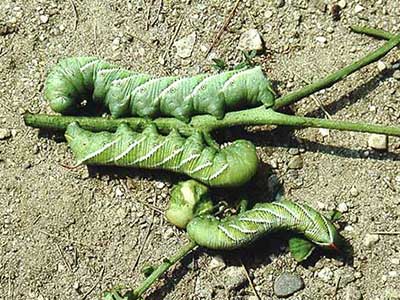 |
| Hornworms on tomato |
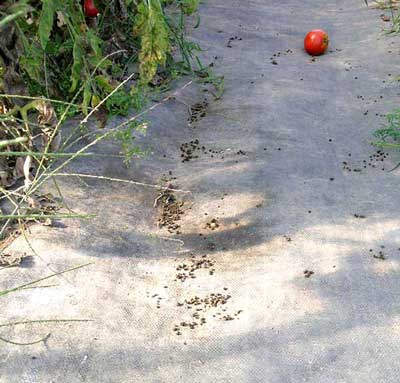 |
| Hornworm frass |
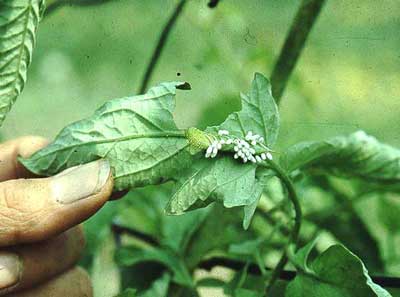 |
| Tomato hornworm hosting braconid wasp cocoons. Vern Grubinger photo |
HORNWORMS
Hornworms are probably the most destructive insect attacking tomatoes and they are showing up now. They are giant caterpillars that can do a vast amount of eating in a very short amount of time. Right now you may find young, tiny ones. Sometimes it seems that healthy looking tomato or pepper plants are stripped of their leaves overnight, leaving bare stems. The hornworms will also attack fruit, eating gouges out so large that they look more like bites of a furry animal than an insect.
Look now for feeding damage and frass (insect poop) around tomato and pepper plants. The frass may be your first sign there is a problem. The frass of young hornworms is small, but quickly the hornworms grow large and so does the frass. I don’t bother looking for the caterpillar because they blend in so well – I just look for the frass.
The adults are large, fast flying hawk moths, which in flight may look like a hummingbird. At dusk they hover over flowers sucking nectar. Eggs are laid on tomato leaves and hatch in 5 days. They are most often found dead or dying among or nearby a tomato crop, after having laid their eggs.
Hand picking is a bit frightening but does work and chickens enjoy fighting with the challenging pest. The problem with hand picking is that they blend in very well and it is easy to overlook one or two caterpillars, which can do significant damage in a day or two. Many growers report that using a black light at night helps to find them, as the caterpillars fluoresce brightly.
Bt works very well on this caterpillar.
What are those white things on tomato hornworms?
Tomato hornworm larvae are parasitized by a number of insects. One of the most common is a small braconid wasp, Cotesia congregatus. Larvae that hatch from wasp eggs laid on the hornworm feed on the inside of the hornworm until the wasp is ready to pupate. The cocoons appear as many small white projections protruding from the hornworm’s body. Parasitized hornworms should be left in the field to conserve the beneficial parasitoids. The wasps will kill the hornworms when they emerge from the cocoons, and will seek out other hornworms to parasitize.
CUCURBIT DOWNY MILDEW
Cucurbit downy mildew has been verified on cucumbers in New Jersey, and most recently in New York State. Because of prevailing west-to-east weather patterns, there is a chance that this disease will continue its spread towards us, though current forecasts do not place Maine in a risk category (refer back to that website as needed – it is updated regularly).
Cucurbit downy mildew can be very destructive if conditions are favorable to it. Like cucurbit powdery mildew, this disease does not overwinter here, and its severity in any given season is often dependent upon when it arrives, if at all.
The first noticed symptoms of cucurbit downy mildew are often angular yellow leaf spots, which are angular because they are constrained by leaf veins. Corresponding dark lesions, and sometimes spores, are seen on the bottom of the leaf as the disease develops. This website from Cornell has links to lots of photos to compare with and more information.
The best “control” is to choose resistant varieties, when available. Some strains of the disease have overcome resistance in older cucumber varieties, but new varieties have been developed, and ‘NY 264’ and ‘Bristol’ have been promising in trials in Long Island and at the University of Massachusetts.
Materials for controlling fungi, and fungi-like diseases like downy mildew, are most effective when applied preemptively, so watching for the spread of the disease is important. Scouting should start in earnest when the disease has been reported nearby.
For farm-scale control options, you can consider a a copper product and/or a bio-fungicide like Actinovate, DoubleNickel, etc. Zonix should also have some effect against zoospores produced by the disease, however, cucurbit downy mildew can produce another spore type and there’s no easy way to know which type of spore might be blown to your field.
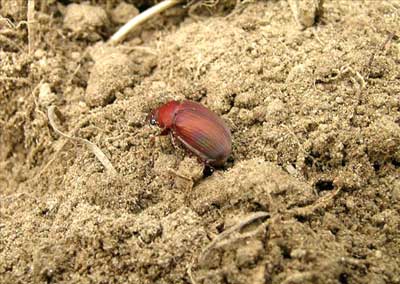 |
| Asiatic garden beetle |
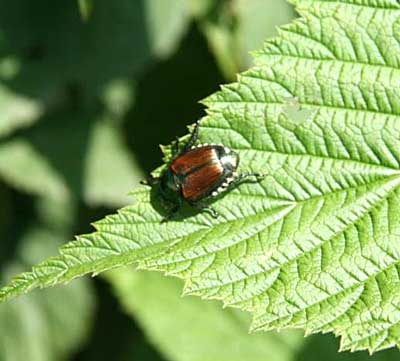 |
| Japanese beetle |
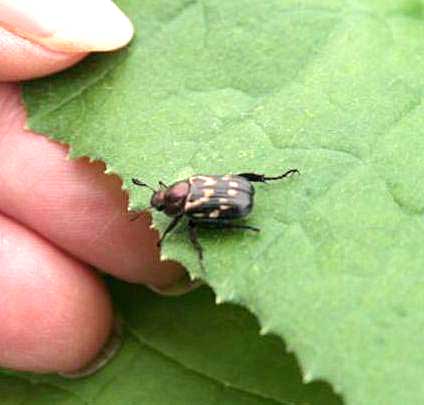 |
| Oriental beetle |
SCARAB BEETLES (Asiatic Garden, Japanese, Oriental, Chafers)
There are four species of scarab beetles that are common in New England turf, fruit and vegetable crops. These were all introduced to the US. Japanese beetles are the most common and widely distributed, but Oriental and Asiatic Garden beetles are expanding their range and activity. Below are brief descriptions.
Asiatic garden beetle
There are regional reports of Asiatic garden beetle feeding on basil and other plants. The Asiatic Garden Beetle is a native of Japan and China where it is not an important pest. The pest overwinters in the soil as a grub feeding on the roots in sod ground and weedy gardens. Some farmers report problem with the grubs in their crop fields (strawberries especially). The larvae (grubs) pupate early in the spring and the resulting adults emerge in June and start feeding on all sorts of garden vegetables. The adults are cinnamon-to reddish brown, rounded beetles. They eat big and irregular holes in leaves and blossoms. You have to look hard to find them because they feed at night and burrow into the soil for the day. If you see chewed leaves and no pest, then go out at night with a flashlight and see who is there. It will probably be cutworms, or the Asiatic garden beetle.
If you have the problem, fall clean up with tilling the garden is important. Pesticides offer some control but often the beetles are very numerous and seem to return from nowhere. Spinosad (Entrust and Monterey Garden Spray) has been reported to work well.
Japanese beetle
Japanese beetle adults are about half an inch long, with a metallic green head. The wings are shiny copper or bronze color, and there are a few tufts of white “fur” along the side of each wing when it is folded back over the body. The adults are active in daylight and feed on many different kinds of trees, fruit and flower crops. Fruit and ornamental plants are preferred, but beetles can congregate in vegetables also. In vegetables, adults can cause silk clipping in corn, and leaf damage in sweet basil, collards, other greens, green beans, eggplant, asparagus, rhubarb, and peppers.
Adult beetles are attracted to brambles (raspberries, blackberries, etc) and prefer to lay their eggs in lawns, where the larvae can later become a grub problem. Though numbers may be high, there is no need to treat unless actual feeding damage is significant. In corn, if there are more than two Japanese beetles per ear and corn is less than 50% pollinated, an application may be warranted to reduce clipping and ensure adequate pollination. Adults can be excluded from basil and other greens with row cover.
Though it might be satisfying to see a Japanese beetle trap nearly bursting at the seams with captured beetles, the pheromone lure is actually too successful and can draw in beetles from miles around. Many never make it into the traps and females can go on to lay eggs around the area, possibly setting the stage for a population boom the following year.
Oriental beetle
Oriental beetles fly at night, but are very active during the day as well. The beetles are smaller than Japanese beetles, and usually are a rather mottled gray with black splotches. The pattern and color varies. Occasionally an individual will be almost all black or almost all gray. The antennae are branched and are quite striking if you take a close look. Oriental beetles have a long flight period – through early August – and are very mobile. Adults tend not to feed heavily in vegetable crop foliage. Grub damage may be worse in drought years and in weedy fields, but is not commonly a problem in vegetable fields and crops, though this is not well studied.
A fourth species may also be found: European chafers, which are slightly larger than Japanese beetles and are a fairly dull brown or tan in color. They are night fliers but can be seen in large numbers just at sunset, when they congregate in large numbers in favorite trees (such as locust or willow). Adults are not foliage feeders and grubs are mostly a turf problem.
(Original modified from a report in the Umass Vegetable Newsletter)
